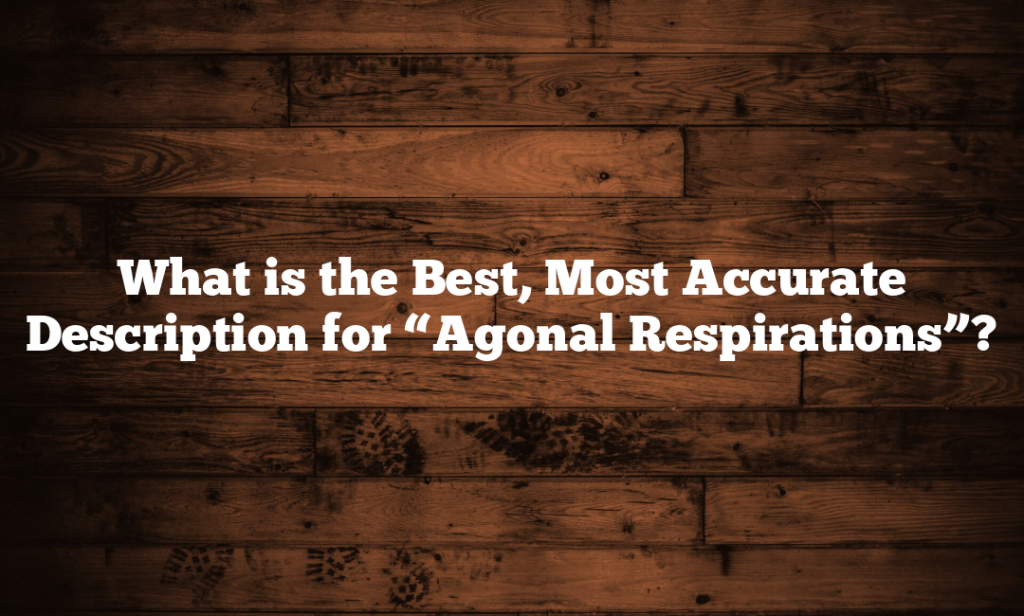What is the Best, Most Accurate Description for “Agonal Respirations”?
Agonal respirations are considered a sign of impending respiratory or cardiac arrest and require immediate medical attention. This type of breathing may sound like irregular gasps or labored breaths, and it is indicative of a critical medical emergency. Recognizing and responding to agonal respirations promptly can be crucial in providing life-saving interventions.
Table of Contents
ToggleUnderstanding the significance of agonal respirations can empower individuals to take immediate action and seek emergency medical assistance when they encounter someone exhibiting these breathing patterns.
Understanding Agonal Respirations
Agonal respirations refer to the gasping breaths or respiratory pattern that occurs in individuals who are in the dying process. They are often seen as a sign of impending death. In this state, the individual’s body is struggling to maintain oxygen supply and carbon dioxide elimination. The causes of agonal respirations can include cardiac arrest, brain injury, or severe trauma. It is important to note that agonal respirations are not normal breathing and should not be confused with signs of life.
Characteristics of agonal respirations include irregular or infrequent breathing, shallow breaths, gasping or choking sounds, and lack of normal breathing effort. The breaths may be accompanied by other signs of distress, such as pale skin or loss of consciousness. It is crucial for healthcare professionals to be able to recognize and differentiate agonal respirations from normal breathing patterns in order to accurately assess and provide appropriate care for the patient in their end-of-life stage.
Common Misconceptions
One of the most common misconceptions regarding agonal respirations is that they are indicative of normal breathing. However, this is not the case. Agonal respirations should not be confused with regular breathing patterns, as they are characterized by irregular, gasping breaths. While normal breathing is consistent, rhythmic, and effortless, agonal respirations are sporadic, shallow, and often accompanied by a gasping sound.
It is important to differentiate agonal respirations from gasping, as they are two distinct phenomena. Agonal respirations occur during the final stages of life and are a reflexive response of the body. On the other hand, gasping is a survival mechanism that can occur in various situations, such as during a cardiac arrest or near-drowning. Gasping is a more forceful and purposeful action compared to agonal respirations. Recognizing the differences between these two can provide vital information to medical professionals and help guide appropriate interventions.
The Significance In Emergency Situations
Agonal respirations are often seen as the body’s last attempt to take in oxygen before death. Observing for 1-2 minutes is crucial in emergency situations. The key is to differentiate them from other respiratory conditions such as gasping or agonal breathing. Recognition helps in prompt medical response and layperson CPR. It’s essential to train individuals to identify these respirations to save lives.
Providing Accurate Descriptions
Agonal respirations are a form of breathing that occurs when a person is in the process of dying. This is a critical medical term as it signifies a medical emergency. Perhaps using descriptive language such as “struggling, gasping, or labored” can help in better understanding and detection. Medical professionals should provide accurate descriptions to ensure proper diagnosis and treatment. Communicating with clear and concise language is crucial during such critical moments.
Conclusion
Determining the best, most accurate description for “agonal respirations” is crucial for medical professionals. A thorough understanding of this term and its implications can aid in providing timely and effective medical interventions. By delving into the complexities and nuances of this phenomenon, healthcare providers can improve patient outcomes and enhance end-of-life care.
Stay informed and stay prepared to respond during critical moments.




